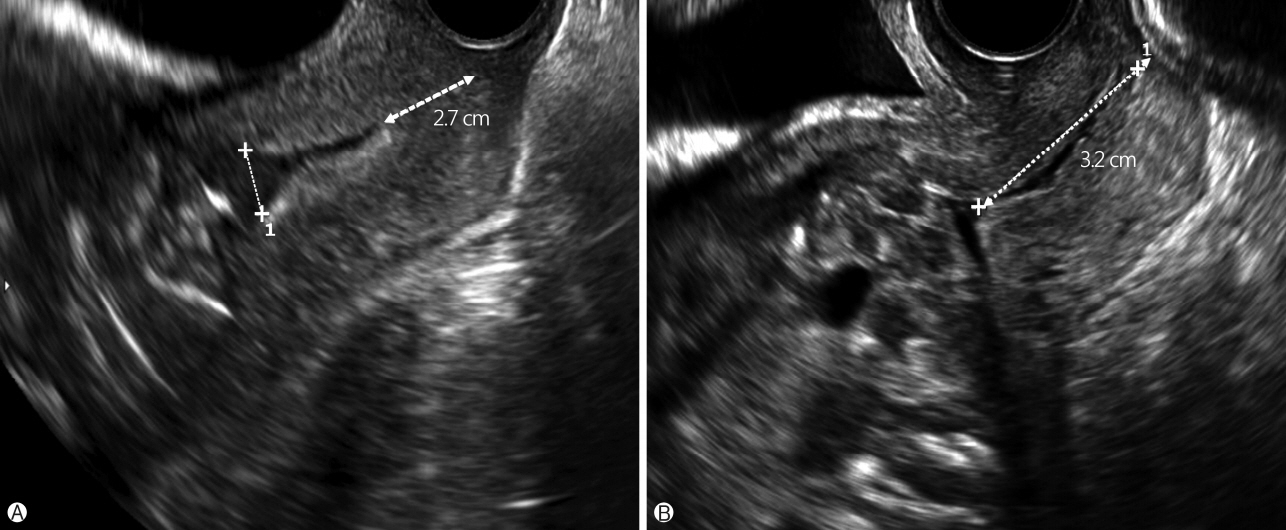Yeungnam Univ J Med.
2018 Jun;35(1):135-139. 10.12701/yujm.2018.35.1.135.
Successful delayed-interval delivery performed 128 days after the vaginal delivery of the first fetus in a twin pregnancy
- Affiliations
-
- 1Department of Obstetrics and Gynecology, Yeungnam University College of Medicine, Daegu, Korea. yujinkoo@yu.ac.kr
- KMID: 2415748
- DOI: http://doi.org/10.12701/yujm.2018.35.1.135
Abstract
- There has been a significant increase in the number of multiple pregnancies that are associated with a high risk of preterm delivery among Korean women. However, to date, delayed-interval delivery in women with multiple pregnancy is rare. We report a case of delayed-interval delivery performed 128 days after the vaginal delivery of the first fetus in a dichorionic diamniotic twin pregnancy. The patient presented with vaginal leakage of amniotic fluid at 16 weeks of gestation and was diagnosed with a preterm premature rupture of membranes. Three days later, the first twin was delivered, but the neonate died soon after. The second twin remained in utero, and we decided to retain the fetus in utero to reduce the morbidity and mortality associated with a preterm birth. The patient was managed with antibiotics and tocolytics. Cervical cerclage was not performed. The second twin was delivered vaginally at 34 weeks and 5 days of gestation, 128 days after the delivery of the first-born fetus. This neonate was healthy and showed normal development during the 1-year follow-up period. Based on our experience with this case, we propose that delayed-interval delivery may improve perinatal survival and decrease morbidity in the second neonate in highly selected cases.
MeSH Terms
Figure
Reference
-
1. Korean Statistical Information Service. Birth and death statistics twin birth [Internet]. Daejeon: KOSIS;2016. [cited 2018 May 5]. http://kosis.kr/index/index.do.2. Livingston JC, Livingston LW, Ramsey R, Sibai BM. Second-trimester asynchronous multifetal delivery results in poor perinatal outcome. Obstet Gynecol. 2004; 103:77–81.
Article3. Carson JL. Twins born with an interval of forty-four days. Br Med J. 1880; 1:242.4. Zhang J, Hamilton B, Martin J, Trumble A. Delayed interval delivery and infant survival: a population-based study. Am J Obstet Gynecol. 2004; 191:470–6.
Article5. Fayad S, Bongain A, Holhfeld P, Janky E, Durand-Réville M, Ejnes L, et al. Delayed delivery of second twin: a multicentre study of 35 cases. Eur J Obstet Gynecol Reprod Biol. 2003; 109:16–20.
Article6. Wittmann BK, Farquharson D, Wong GP, Baldwin V, Wadsworth LD, Elit L. Delayed delivery of second twin: report of four cases and review of the literature. Obstet Gynecol. 1992; 79:260–3.7. Kalchbrenner MA, Weisenborn EJ, Chyu JK, Kaufman HK, Losure TA. Delayed delivery of multiple gestations: maternal and neonatal outcomes. Am J Obstet Gynecol. 1998; 179:1145–9.
Article8. Oyelese Y, Ananth CV, Smulian JC, Vintzileos AM. Delayed interval delivery in twin pregnancies in the United States: Impact on perinatal mortality and morbidity. Am J Obstet Gynecol. 2005; 192:439–44.
Article9. Lee EH, Sohn JA, Lee JY, Choi EJ, Lee JA, Choi CW, et al. The impact of delayed interval delivery on neonatal mortality and morbidity. J Korean Soc Neonatol. 2011; 18:111–6. Korean.
Article10. Rosbergen M, Vogt HP, Baerts W, van Eyck J, Arabin B, van Nimwegen-Hamberg JM, et al. Long-term and short-term outcome after delayed-interval delivery in multi-fetal pregnancies. Eur J Obstet Gynecol Reprod Biol. 2005; 122:66–72.
Article11. van Doorn HC, van Wezel-Meijler G, van Geijn HP, Dekker GA. Delayed interval delivery in multiple pregnancies. Is optimism justified? Acta Obstet Gynecol Scand. 1999; 78:710–5.12. Arabin B, van Eyck J. Delayed-interval delivery in twin and triplet pregnancies: 17 years of experience in 1 perinatal center. Am J Obstet Gynecol. 2009; 200:154. e1-8.
Article13. Doger E, Cakiroglu Y, Ceylan Y, Kole E, Ozkan S, Caliskan E. Obstetric and neonatal outcomes of delayed interval delivery in cerclage and non-cerclage cases: an analysis of 20 multiple pregnancies. J Obstet Gynaecol Res. 2014; 40:1853–61.
Article14. Zhang J, Johnson CD, Hoffman M. Cervical cerclage in delayed interval delivery in a multifetal pregnancy: a review of seven case series. Eur J Obstet Gynecol Reprod Biol. 2003; 108:126–30.
Article15. Farkou LJ, Sabin ED, Heyborne KD, Lindsay LG, Porreco RP. Delayed-interval delivery: extended series from a single maternal-fetal medicine practice. Am J Obstet Gynecol. 2000; 183:1499–503.
Article16. Ahn HS. A successful delayed-interval delivery without cerclage operation after one fetal delivery in a case of twin pregnancy. Korean J Perinatol. 2009; 20:395–400.17. Sosa C, Althabe F, Belizán J, Bergel E. Bed rest in singleton pregnancies for preventing preterm birth. Cochrane Database Syst Rev. 2004; (1):CD003581.
Article18. Trivedi AN, Gillett WR. The retained twin/triplet following a preterm delivery--an analysis of the literature. Aust N Z J Obstet Gynaecol. 1998; 38:461–5.
Article
- Full Text Links
- Actions
-
Cited
- CITED
-
- Close
- Share
- Similar articles
-
- A Successful Delayed-Interval Delivery without Cerclage Operation after One Fetal Delivery in a Case of Twin Pregnancy
- A Case of Delayed Delivery of Second Twin
- Delayed-Interval Delivery after Cerclage Operation in a Case of Twin Pregnancy with One Fetal Delivery
- Delayed Interval Delivery after Emergency Cerclage of Cervical Incompetency in Twin Pregnancy by in vitro Fertilization
- The perinatal outcome of vaginal delivery in twin pregnancy


